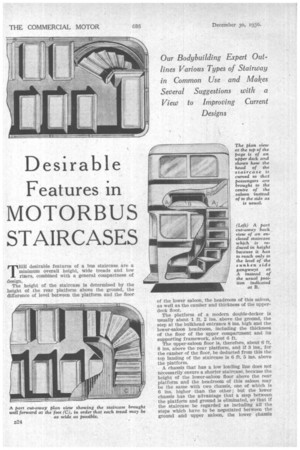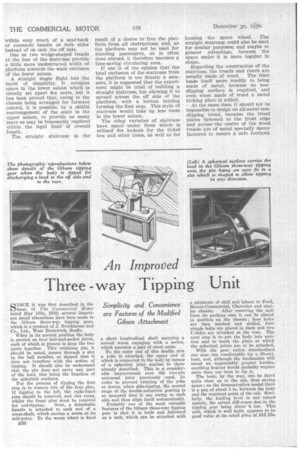Desirable Features in MOTORBUS STAIRCASES
Page 38

Page 39

Page 40

If you've noticed an error in this article please click here to report it so we can fix it.
Our Bodybuilding Expert Outlines Various Types of Stairway in Common Use and Makes Several Suggestions with a View to Improving Current Designs
THE desirable features of a bus staircase are a minimum overall height, wide treads and low risers, combined with a general compactness of design.
The height of the staircase is determined by the height of the rear platform above the ground, the difference of level between the platform and the floor
of the lower saloon, the headroom of this saloon, as well as the camber and thickness of the upperdeck floor.
The platform of a modern double-decker is usually about 1 ft. 2 ins, above the ground, the step at the bulkhead entrance 8 ins, high and the lower-saloon headroom, including the thickness of the floor of the upper compartment and its supporting framework, about 6 ft.
The upper-saloon floor is, therefore, about 6 ft. 8 ins, above the rear platform, and if 3 ins., for the camber of the floor, be deducted from this the top landing of the staircase is 6 ft. 5 ins, above the platform.
• A chassis that has a low loading line does not necessarily ensure a shorter staircase, because the height of the lower-saloon floor above the rear platform and the headroom of this saloon may be the same with two chassis, one of which is 6 ins. higher than the other ; but the lower chassis has the advantage that a step between the platform and ground is eliminated, so that if the staircase be regarded as including all the steps which have to be negotiated between the ground and upper saloon, the lower chassis is the better from the staircase point of view.
Similarly, the staircase is not really shortened if the body be mounted on a chassis having no cranked tail end, and the platform and lowersaloon floor be on the same level, because the omission of the step at the bulkhead entrance has to be made good at the edge of the platforin.
• A more effective reduction of the height of the staircase is made when the upper saloon has sunk side gangways, because the full headroom of the lower saloon does not affect so directly the position of the top landing, which in this instance is controlled by the specially reduced headroom at the sides of the lower saloon.
With sunk side gangways to the upper saloon the staircase may have one tread fewer than that of the conventional pattern. In some instances there may be a difference of two treads, but the reduction of the number of treads has the disadvantage that it increases the height of the risers.
The riser should be designed in order that each stair is from 9/t ins. to 9i ins. high. The treads will vary in width and shape according to the arrangement of the staircase.
Looking at the staircase in plan, it consists of a curved, angular or straight strip made up of the assembled treads. Except with the straight staircase the passenger has to travel, while on the stairs, through an angle of approximately 90 degrees.
If the staircase be wholly curved•in plan or of the spiral pattern the
treads are wedge shaped and are narrower on the inside than dn the outside. The inside line of the staircase plan must, therefore, be carefully considered in order that at this point the treads be not dangerously narrow. This inside line must not be lengthened by decreasing the width of the staircase, but by increasing its overall,length in plan.
The length of the staircase depends chiefly on that of the rear platform. The length of the curve that it describes may be increased by encroaching into the lower saloon, so that the top tread is in front instead of behind the bulkhead. Wider treads are possible by lengthening the staircase at the foot, which in turn will influence the amount of free space remaining on the platform.
The present tendency of staircase design is to make this bottom landing a comparatively large one. Formerly it was only a few inches wider than one of the treads. To-day it is at least twice the width of a tread, the measurement varying from 1 ft. 8 ins. to 1 ft. 10 ins.
The length of the staircase is also increased by the simple expedient of doing away with the boldly rounded corner used with the open staircase and planning the staircase enclosure so that, with only a small radius at the off-side rear corner, it is almost right-angular when viewed from above.
This shape gives scope for introducing a fairly large half landing between an upper and lower flight, each comprising three or four steps. Both flights may be straight, or nearly so. The half landing, if large enough, may be used as a means for allowing two persons to pass one another on the stairs. The straighter the flights,the less is the need for wedge-shaped treads.
Although a straight flight represents the ideal it is often necessary to effect a compromise by curving it a little.
If the upper part be curved towards the centre top gangway the passenger arrives on what is usually a flatter part of the floor. When the upper deck is enclosed there is no necessity of any pronounced roof camber to throw the water to the sides ; therefore, this style of top landing may not appear to be of any great advantage. However, a central landing places the passengers within easy reach of a seat-back or commode handle on both sides instead of on only the off side.
One or two wedge-shaped treads at the foot of the staircase provide a little more unobstructed width of platform towards the knain entrance of the lower saloon.
A straight single flight has the merit of simplicity. It occupies space in the lower saloon which is usually set apart for seats, but it has been proved that, owing to the chassis being arranged for forward control, it is possible, by a skilful rearrangement of the seats in the upper saloon, to provide as many seats as may be reasonably required within the legal limit of overall length.
The straight staircase is the result of a desire to free the platform from all obstructions, and, as the platform may not be used for standing passengers, as is often done abroad, it therefore becomes a time-saving circulating area.
If one is of the opinion that the total exclusion of the staircase from the platform is too drastic a measure, it is suggested that the experiment might be tried of building a straight staircase, but allowing it to spread across the off side of the platform, with a bottom landing forming the first step. This style of staircase would take up less room in the lower saloon.
The other varieties of staircase have space under them which is utilized for lockers for the ticket box and other items, 'as well as for housing the spare wheel. The straight staircase could also be used for similar purposes, and maybe to greater advantage, because the space under it is more regular in shape.
Regarding the construction of the staircase, the treads and risers are usually made of wood. The riser lends itself more readily to being made of metal, because no nonslipping surface is required, and even when made of wood a metal kicking plate is added.
At the same time, it should not be Impossible to design an all-metal nonslipping tread, because the tread plates fastened to the front edge and across-the centre of the woodtreads are of metal specially manufactured to ensure a safe foothold.




























































































